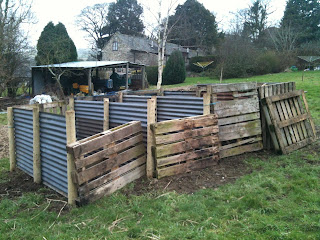When the former owners of these properties designed our holiday cottage, Gwenoldy, and had it created from the former stable and forge, they wisely chose not to affix a television aerial to the building. And, as there was no loft space in which to hid the antenna, they ran the lead underground for thirty yards and put the aerial on the corner of the postbarn, home of the 1964 Fordson Super Dexta tractor.
In a couple of weeks the postbarn will be demolished and replaced by an enclosed 'implements store', approved by the planners to support our horticultural activities. This will be a largely steel construction, but it has been designed in two sections to deal with the sloping site and mimic the construction of the original bakehouse and pigsties on the other side of the horseshoe-shaped 'courtyard'. It's going to be constructed and erected for us by a firm which specialises in agrictultural buildings.
In the meantime, however, there is the minor issue of maintaining the TV signal to the cottage. From our track we can see the Moel y Parc transmission tower, all 850 feet of it.
This carries, amongst other things, TV and radio signals for North East Wales, and clearly had to act as inspiration for my temporary structure (our aerial will go back in due course on the new outbuilding).
So on Saturday the workshop was raided for bolts, the recycled woodpile for posts, and, with the use of both the post rammer (beast) and the maul (slightly less of a beast) our stony soil was penetrated to provide a firm foundation for our mast - all 25 feet of it.
Yes, I know, it looks like the kind of flagpole scouts (used to?) erect at camp. Not quite in keeping with our luxury, 5-star cottage. I agree, but it is only temporary, and do you have any better ideas?
Monday, 27 February 2012
Thursday, 16 February 2012
Fire!
One of the great things about living where we do now, with plenty of outside space, is being able to indulge my love of bonfires. We are pretty good about recycling what we can: timber of any size gets cut up to feed the woodburning stove, glass, plastic, newspapers and tins go to the recycling centre, and we produce very little actual waste for the wheely bin. We also compost just about anything from the garden that will rot down to go back on the soil. This is how our (main) compost bins look now, with the corrugated metal panels which were in stock for the postbarn extension before the plan for the completely new implement store emerged.
And food waste? Well we tend not to have it - isn't food for eating? But we save miscellaneous paper to burn in the field as a starter for the clippings and perennial weeds which can't be composted.
So every now and then I have the fun of managing an unruly heap from this:
to this:
In my experience, not everyone realises what a skilled, responsible and time-consuming task this is, feeling rather that the three hours or so spent in this way could have been devoted to rather more pressing and creative tasks - digging, weeding, etc. However, a true fire-raiser must stand up for his art.
Just in case anyone feels that not enough real work has been going on in the field recently, here is proof of stone-moving on a grand scale. I have been bagging and stacking our rough field stone for years pending the rebuilding of broken drystone walls around the outbuildings, and it has had to be moved to clear the site for the new store.
Having discovered that UV light makes a real mess of plastic bags in 5 years or so, this time it is going on a bed of corrugated sheets, thus:
This corner of the field will need a new name - Stone Store and Snail Sanctuary are the current possibilities.
And food waste? Well we tend not to have it - isn't food for eating? But we save miscellaneous paper to burn in the field as a starter for the clippings and perennial weeds which can't be composted.
So every now and then I have the fun of managing an unruly heap from this:
to this:
In my experience, not everyone realises what a skilled, responsible and time-consuming task this is, feeling rather that the three hours or so spent in this way could have been devoted to rather more pressing and creative tasks - digging, weeding, etc. However, a true fire-raiser must stand up for his art.
Just in case anyone feels that not enough real work has been going on in the field recently, here is proof of stone-moving on a grand scale. I have been bagging and stacking our rough field stone for years pending the rebuilding of broken drystone walls around the outbuildings, and it has had to be moved to clear the site for the new store.
Having discovered that UV light makes a real mess of plastic bags in 5 years or so, this time it is going on a bed of corrugated sheets, thus:
This corner of the field will need a new name - Stone Store and Snail Sanctuary are the current possibilities.
Subscribe to:
Comments (Atom)






